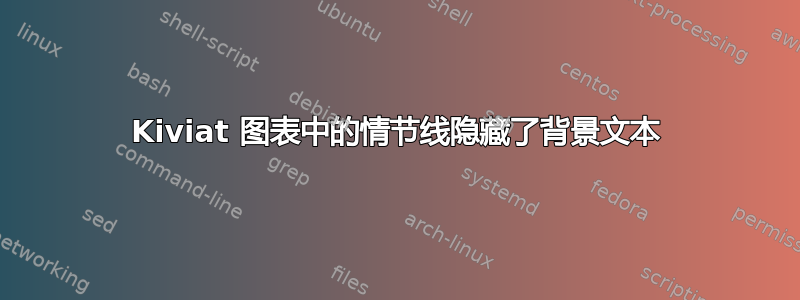
以下是 tkz-kiviat 包中的六边形 Kiviat 图表。虽然制作的图表足够漂亮,但图表的线条隐藏了背景文本。我还使用了 stackengine 和 adjustbox 包,将文本与箭头对齐到看起来漂亮的位置,但两个文本框“黑暗的”和“维护良好”不会移动,但有一点成功。忽略图例设置,我需要背景文本清晰显示,没有线条切断它。以下是使用的代码:
\documentclass[10pt,a4paper]{article}
\usepackage[utf8]{inputenc}
\usepackage[T1]{fontenc}
\usepackage{multirow}
\usepackage{mathptmx}
\usepackage{xcolor}
\usepackage{tikz,tkz-kiviat}
\usepackage{arrayjobx}
\usetikzlibrary{decorations.pathreplacing, arrows, fit,backgrounds,positioning,shapes,plotmarks,calc,decorations,angles,decorations.markings,intersections}
\usepackage[export]{adjustbox}
\usepackage{stackengine}
\tikzset{ultra thick,>=latex}
\makeatletter
\usepackage{trimspaces}
\def\trimspace#1{\trim@spaces@in{#1}}
\makeatother
\newarray\kivaxisitemlabels
\readarray{kivaxisitemlabels}{%
& \stackinset{c}{-0.75cm}{c}{-0.75cm}{Dark}{} &\stackinset{c}{-2.25cm}{c}{-0.1cm}{\multirow{1}[3]{4.5cm}{\centering brownies/wheatish (fair looking)}}{} & whitish & &
&\stackinset{c}{-1.45cm}{c}{-1.2cm}{strong}{} &\stackinset{c}{-1.55cm}{c}{-0.9cm}{active}{} & \stackinset{c}{-2.7cm}{c}{1cm}{weaklings}{} & &
&\stackinset{c}{0.9cm}{c}{0.5cm}{pessimistic}{}& \stackinset{c}{0.5cm}{c}{0.2cm}{\multirow{1}[3]{3cm}{\centering optimistic}}{} & \stackinset{c}{0.4cm}{c}{0.5cm}{Realistic}{} & &
& \stackinset{c}{0.6cm}{c}{0.7cm}{\multirow{1}[1]{3cm}{\centering well motivated}}{} & \stackinset{c}{0.5cm}{c}{0.9cm}{lethargic}{} & demotivated & &
&\stackinset{c}{2.8cm}{c}{1.5cm}{Gigantic/Dwarfs}{} &Normal & Average & &
& \stackinset{c}{-0.8cm}{c}{0.2cm}{Handsome men }{} &\stackinset{c}{-0.5cm}{c}{0.2cm}{Ugly boys}{} & \stackinset{c}{-0.5cm}{c}{0.2cm}{beautiful ladies}{} & & }
\dataheight=5
\newcommand{\kivcurrentlabel}[2]{\checkkivaxisitemlabels(#1,#2)\trimspace\cachedata \cachedata}
\newcommand{\kivaxisnumbers}{6}
\newcommand{\kivcategorycounts}{{3,3,3,3,3,3}}
%\newcommand{\kivkumulativecategorycounts}{{0,2,5,9,13,17}}
%\newcommand{\kivcategorynames}{{1,2,10,20,30,100,200,300,400}}
\newcommand{\kivlcmcatcount}{3}
\newcommand{\kivlattice}{%
\pgfmathsetmacro{\kivaxisangle}{360/\kivaxisnumbers}
\foreach \x in {1,...,\kivaxisnumbers}
{ \foreach \y in {1,...,\kivlcmcatcount}
{ \pgfmathsetmacro{\kivaxisstep}{6/\kivlcmcatcount}
\draw[help lines] (\kivaxisangle*\x:\y*\kivaxisstep) -- (\kivaxisangle*\x+\kivaxisangle:\y*\kivaxisstep);
}
}
\foreach \x in {1,...,\kivaxisnumbers}
{ \draw[ultra thick,-|] (0,0) -- (\kivaxisangle*\x:1.0cm);
\draw[ultra thick,->|] (0,0) -- (\kivaxisangle*\x:3.8cm);%-latex,line width=0.55mm
\draw[ultra thick,->|] (0,0) -- (\kivaxisangle*\x:6.8cm);
\pgfmathsetmacro{\kivaxissteps}{\kivcategorycounts[\x-1]}
\pgfmathsetmacro{\kivaxisstep}{8.5/\kivcategorycounts[\x-1]}
\foreach \y in {1,...,\kivaxissteps}
{ %\pgfmathsetmacro{\kivhelper}{\kivkumulativecategorycounts[\x-1]}
%\pgfmathtruncatemacro{\kivlabelname}{\kivcategorynames[\kivhelper+\y-1]}
%\node[circle,fill=black,label=\x*\kivaxisangle+90:\kivlabelname,inner sep=1pt] at (\kivaxisangle*\x:\kivaxisstep*\y) {};
\pgfmathtruncatemacro{\kivlabelnumber}{\y+1}
\node[label=\x*\kivaxisangle+60:\kivcurrentlabel{\x}{\kivlabelnumber}] at (\kivaxisangle*\x:\kivaxisstep*\y) {};
}
}
}
\newcommand{\LegendBox}[3][]{%
\xdef\fitbox{}%
\coordinate[#1] (LegendBox_anchor) at (#2) ;
\foreach \col/\item [count=\hi from 0] in {#3} {
\node[color = \col,draw,
fill = \col,
shape=circle,
inner sep=1.2ex,
name=b\hi,
] at ([yshift=\hi*4 ex,xshift=3ex]LegendBox_anchor) {};
\node[anchor=west,xshift=1ex] at (b\hi.east) (c\hi) {\item};
\xdef\fitbox{\fitbox(c\hi)}
}%
\node [draw,fit=\fitbox(LegendBox_anchor)] {};
}
\makeatletter
\definecolor{A1}{RGB}{166, 206, 227}
\definecolor{B2}{RGB}{31, 120, 180}
\definecolor{C3}{RGB}{178, 223, 138}
\definecolor{D4}{RGB}{51, 160, 44}
\definecolor{E5}{RGB}{251, 154, 153}
\definecolor{F6}{RGB}{227, 26, 28}
\definecolor{G7}{RGB}{253, 191, 111}
\definecolor{H8}{RGB}{255, 127, 0}
\definecolor{I9}{RGB}{202, 178, 214}
\definecolor{J10}{RGB}{106, 61, 154}
\definecolor{K11}{RGB}{255, 255, 153}
\definecolor{L12}{RGB}{177, 89, 40}
\definecolor{M13}{RGB}{140, 135, 32}
\definecolor{N14}{RGB}{231, 41, 138}
\definecolor{O15}{RGB}{135, 135, 135}
\definecolor{P16}{RGB}{53, 151, 143}
\begin{document}
\begin{figure}[!h]
\begin{adjustbox}{max totalsize={1.5\textwidth},center}
\begin{tikzpicture}[label distance=.15cm]
\begin{scope}
\tkzKiviatDiagram[font= \Large\bf, align=center, line width=1.15 mm, scale=1.25, label distance=.15cm,step=1.25,label space =1.25, gap= 1,lattice=10, lattice space=2]%
{People \parbox{1cm}{\centering distribution} ,Color \parbox{2cm}{\centering complexion},Physical \parbox{1cm}{\centering appearance},Nature,Phycology,Height}
% \draw (0,0) node [midway] {\textbf{\Large GRMMC}};
\kivlattice
\tkzKiviatLine[line width=0.35mm,color=A1,mark={*},
mark size=3.5pt](0.95,3.15,0.95,3.15,3.15,0.95)
\tkzKiviatLine[line width=0.35mm,color=B2,mark={*},
mark size=3.5pt](5.55,3.35,5.95,3.35,5.55,3.7)
\tkzKiviatLine[line width=0.35mm,color=C3,mark={*},
mark size=3.5pt](5.75,3.55,6.15,0.95,3.35,3.9)
\tkzKiviatLine[line width=0.35mm,color=D4,mark={*},
mark size=3.5pt](5.95,3.75,6.35,3.55,5.75,1.15)
\tkzKiviatLine[line width=0.35mm,color=E5,mark={*},
mark size=3.5pt](6.15,3.95,6.55,1.15,5.95,4.1)
\tkzKiviatLine[line width=0.35mm,color=F6,mark={*},
mark size=3.5pt](6.35,6.35,6.75,1.35,6.15,1.35)
\tkzKiviatLine[line width=0.35mm,color=G7,mark={*},
mark size=3.5pt](6.55,6.55,6.95,1.55,6.35,1.55)
\tkzKiviatLine[line width=0.35mm,color=H8,mark={*},
mark size=3.5pt](3.15,6.75,3.15,6.55,6.55,1.75)
\tkzKiviatLine[line width=0.35mm,color=I9,mark={*},
mark size=3.5pt](6.75,6.95,1.15,6.75,6.75,1.95)
\tkzKiviatLine[line width=0.35mm,color=J10,mark={*},
mark size=3.5pt](1.15,4.15,3.35,3.75,6.95,2.15)
\tkzKiviatLine[line width=0.35mm,color=K11,mark={*},
mark size=3.5pt](6.95,4.35,3.55,6.95,7.15,4.3)
\tkzKiviatLine[line width=0.35mm,color=L12,mark={*},
mark size=3.5pt](7.15,4.55,7.15,3.95,7.35,2.35)
\tkzKiviatLine[line width=0.35mm,color=M13,mark={*},
mark size=3.5pt](3.35,0.95,7.35,4.15,3.55,5.7)
\tkzKiviatLine[line width=0.35mm,color=N14,mark={*},
mark size=3.5pt](7.35,4.75,3.75,1.75,7.55,2.55)
\tkzKiviatLine[line width=0.35mm,color=O15,mark={*},
mark size=3.5pt](7.55,7.15,3.95,7.15,7.75,4.5)
\LegendBox[shift={(-25cm,-3cm)}]{current bounding box.south east}%
{A1/ 1,
B2/ 2,
C3/ 3 }
\LegendBox[shift={(-20cm,0.4cm)}]{current bounding box.south east}%
{D4/ 4,
E5/ 5,
F6/ 6 }
\LegendBox[shift={(-15cm,0.42cm)}]{current bounding box.south east}%
{G7/ 7,
H8/ 8,%\cite{Guo2020}ZHOU201993
I9/ 9 }
\LegendBox[shift={(-10cm,0.44cm)}]{current bounding box.south east}%
{J10/ 10,
K11/ 11,
L12/ 12 }
\LegendBox[shift={(-5cm,0.46cm)}]{current bounding box.south east}%
{M13/ 13,
N14/ 14,
O15/ 15 }
\end{scope}
\end{tikzpicture}
\end{adjustbox}
\caption{Conclusive findings from the literature after a hasty uncontrolled view }
\label{Fig_fig:16New}
\end{figure}
\end{document}
答案1
TikZ 按照您在代码中提供的顺序绘制元素(有一些例外,特别是 tikzlibrary backgrounds)。
因此,如果您希望情节标记位于箭头线的顶部,并且文本标签位于所有内容的顶部,那么您应该首先放置箭头线的代码,然后放置情节标记的代码,然后放置文本标签的代码。
箭头线和文本标签在\kivlattice宏中一起绘制。因此,要单独绘制它们,您需要将宏分成两部分,这需要使用相同的 for 循环两次。然后您可以在\tkzKiviatLine格子的两个部分之间绘制标记。
代码(片段,不重复问题中的完整 MWE):
\newcommand{\kivarrowsonly}{%
\pgfmathsetmacro{\kivaxisangle}{360/\kivaxisnumbers}
\foreach \x in {1,...,\kivaxisnumbers}
{ \foreach \y in {1,...,\kivlcmcatcount}
{ \pgfmathsetmacro{\kivaxisstep}{6/\kivlcmcatcount}
\draw[help lines] (\kivaxisangle*\x:\y*\kivaxisstep) -- (\kivaxisangle*\x+\kivaxisangle:\y*\kivaxisstep);
}
}
\foreach \x in {1,...,\kivaxisnumbers}
{ \draw[ultra thick,-|] (0,0) -- (\kivaxisangle*\x:1.0cm);
\draw[ultra thick,->|] (0,0) -- (\kivaxisangle*\x:3.8cm);%-latex,line width=0.55mm
\draw[ultra thick,->|] (0,0) -- (\kivaxisangle*\x:6.8cm);
}
}
\newcommand{\kivlattice}{%
\pgfmathsetmacro{\kivaxisangle}{360/\kivaxisnumbers}
\foreach \x in {1,...,\kivaxisnumbers}
{ \pgfmathsetmacro{\kivaxissteps}{\kivcategorycounts[\x-1]}
\pgfmathsetmacro{\kivaxisstep}{8.5/\kivcategorycounts[\x-1]}
\foreach \y in {1,...,\kivaxissteps}
{ %\pgfmathsetmacro{\kivhelper}{\kivkumulativecategorycounts[\x-1]}
%\pgfmathtruncatemacro{\kivlabelname}{\kivcategorynames[\kivhelper+\y-1]}
%\node[circle,fill=black,label=\x*\kivaxisangle+90:\kivlabelname,inner sep=1pt] at (\kivaxisangle*\x:\kivaxisstep*\y) {};
\pgfmathtruncatemacro{\kivlabelnumber}{\y+1}
\node[label=\x*\kivaxisangle+60:\kivcurrentlabel{\x}{\kivlabelnumber}] at (\kivaxisangle*\x:\kivaxisstep*\y) {};
}
}
}
%%%%%% [lots of code in between] %%%%%%
\tkzKiviatDiagram[font= \Large\bf, align=center, line width=1.15 mm, scale=1.25, label distance=.15cm,step=1.25,label space =1.25, gap= 1,lattice=10, lattice space=2]%
{People \parbox{1cm}{\centering distribution} ,Color \parbox{2cm}{\centering complexion},Physical \parbox{1cm}{\centering appearance},Nature,Phycology,Height}
% \draw (0,0) node [midway] {\textbf{\Large GRMMC}};
\kivarrowsonly
\tkzKiviatLine[line width=0.35mm,color=A1,mark={*},
mark size=3.5pt](0.95,3.15,0.95,3.15,3.15,0.95)
%%%%%% more \tkzKiviatLine statements here %%%%%%
\tkzKiviatLine[line width=0.35mm,color=O15,mark={*},
mark size=3.5pt](7.55,7.15,3.95,7.15,7.75,4.5)
\kivlattice
\LegendBox[shift={(-25cm,-3cm)}]{current bounding box.south east}%
{A1/ 1,
B2/ 2,
C3/ 3 }
%%%%%% [...] %%%%%%
结果:




